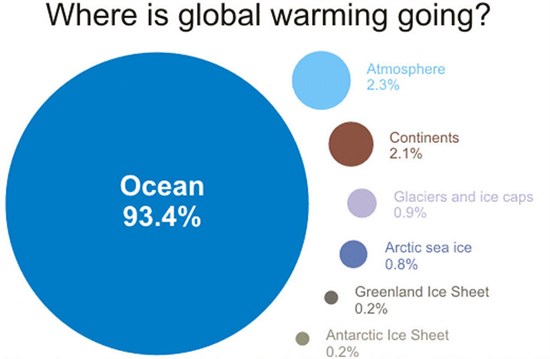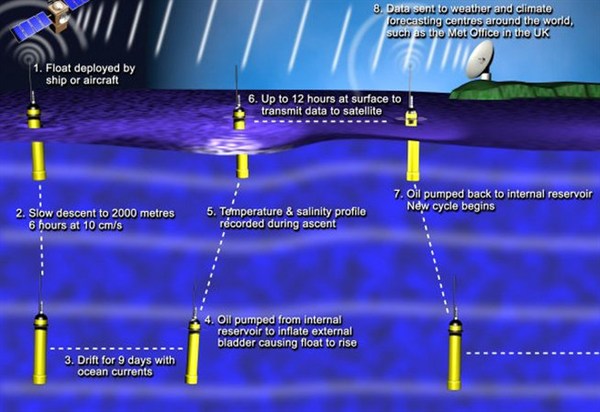Roz Pidcock
21.08.2014 | 7:00pmA flip-flopping natural fluctuation in the Atlantic is behind a recent slowdown in surface warming – and it’s not due to reverse for another ten years, according to new research.
The theory outlined in a paper published today in the journal Science disagrees with other research, which pins the blame for the so-called “pause” on changes in the Pacific.
We talked to some other scientists working in the field – and they don’t seem convinced.
Puzzle solving
Scientists know greenhouse gases are driving up global temperature. But data on land and the surface of the ocean shows slower than expected warming in the last 15 years or so.
Periods of slower and faster warming aren’t unusual. Scientists say the main reason we’re seeing one now is because more heat is finding its way to the deeper ocean, rather than staying at the surface.
But which ocean? Knowing where the heat is ending up might help scientists predict how long the hiatus will last.
More than 93 per cent of the heat reaching earth’s surface goes into the oceans. Just 2.3 per cent stays in the atmosphere. Source: Skeptical Science
Pacific or Atlantic?
This is where the new paper disagrees with most recent research, which points towards cooling in the Pacific Ocean as the driver of the hiatus.
The trade winds in the Pacific have been unusually strong since about 2000, a study last year showed. That’s been driving more heat into the deep ocean, lead author Dr Matthew England told us this week:
“[W[e know there’s been a big increase in the strength of the Pacific trade winds, and this provides a means for accelerating heat uptake in the western Pacific Ocean.”
Scientists think the shift in the trade winds is being driven by a larger natural cycle, the Interdecadal Pacific Oscillation (IPO) cycling between its warm and cold phases.
But the new paper’s authors disagree, saying their findings “don’t support [this] Pacific-centric view”. The heat going into the deep Pacific Ocean “is not nearly enough” to account for the hiatus, they argue.
ARGO floats sink to a depth of about 1,500 metres and come back up to transmit data via satellite. The lifetime of each float is about four years. Source: Met Office
The new research uses data from ARGO floats – a network of free-floating buoys travelling the world’s oceans taking temperature measurements in the top 1,500 metres..
The ARGO data show some heat going into the deep Pacific but not much, say the authors:
“[Our data} shows that during the 21st century, the increased [ocean heat uptake] below 300m occurs mainly in two ocean basins: the Atlantic and the Southern Oceans â?¦ The Pacific shows very little change”.
Since 2000, the North and South Atlantic oceans below 300 metres together took up slightly more heat than all of the other oceans put together, the paper notes. You can see this in the graph below. It shows the amount of heat absorbed by the global ocean (top) and individual ocean basins (smaller panels).
In the Atlantic and Southern Ocean, the top 300m (blue) only accounts for a small amount of the total heat stored in the upper 1,500 metres of the ocean (red).
Now look at the Pacific, where the red and blue lines sit much closer together – meaning almost all the heat stays in the top 300m, rather than being carried off to deeper water.
Heat stored in the global ocean (top) and major oceans compared to the 1970 to 2012 average. Coloured lines show heat from the surface down to different depths (left scale). Black lines are average sea surface temperature (right scale) Source: Chen & Tung (2014)
The amount of heat going into the deep Pacific ocean isn’t enough to explain the hiatus on its own, say the authors. The Atlantic Ocean in particular is playing a far more important role, they argue.
A salty driver of change
The authors suggest unusually salty water in the subpolar Atlantic could have caused a huge slow moving ocean circulation in the Atlantic, known as the Atlantic Meridional Overturning Circulation, to speed up.
A faster circulation means more water plunges from the surface to deeper depths at high latitudes in the North Atlantic, taking with it lots of heat. In the 1970s, 80s and 90s, the opposite happened. Less salty water slowed the circulation down, transporting less water to depth and causing the surface to warm faster, the authors suggest.
In the past, the Atlantic circulation has switched phase every 20 to 35 years, say the authors. Crucially, if they’re right, it means the hiatus could last another decade.
What do other scientists think?
A 2011 paper by Professor Gerald Meehl and colleagues first raised the idea that the Atlantic could play a part in the hiatus – so the suggestion in today’s paper isn’t a new one.
But Meehl and other scientists who work in this area don’t agree the Atlantic Ocean mechanism dominates over the Pacific one in terms of causing the hiatus. England tells us:
“I still think the Pacific Ocean is playing the lead role in this ocean heat uptake but this study is important as it points to an additional role from the Atlantic and Southern Oceans.”
How long the hiatus lasts is likely to have more to do with when natural cycles in the Pacific shift again, rather than those in the Atlantic, Meehl adds:
“Given the available evidence, the IPO in the Pacific seems to be the main driver of the hiatus, and past hiatus periods as well. If, as in the 1970s, the IPO switches from negative to positive, there would be a resumption of more rapid warming.”
Part of the reason for other scientists’ doubts about the new paper’s conclusions are because it uses a different method to previous research. ARGO floats have been collecting data since the early 2000s but only achieved global coverage in 2005, for example.
Professor Kevin Trenberth from the US National Centre for Atmospheric Research tells us the suggested Atlantic mechanism can’t explain the atmospheric disturbances recently, which have lead to extreme weather over the northern hemisphere, including the UK.
Pieces of a puzzle
The hiatus is a complex product of a combination of lots of factors and unravelling how their influences compare is likely to take some time yet.
On top of natural variability, there are smaller contributions from a dip in solar activity and a rise in aerosol pollution to consider, which have an overall cooling effect.
As for how much longer the hiatus will last, it’s probably fair to say making predictions with any degree of certainty is still quite a long way off.
Chen, X. & Tung, K. (2014) Varying planetary heat sink led to global-warming slowdown and acceleration. DOI: 10.1126/science.1255057




